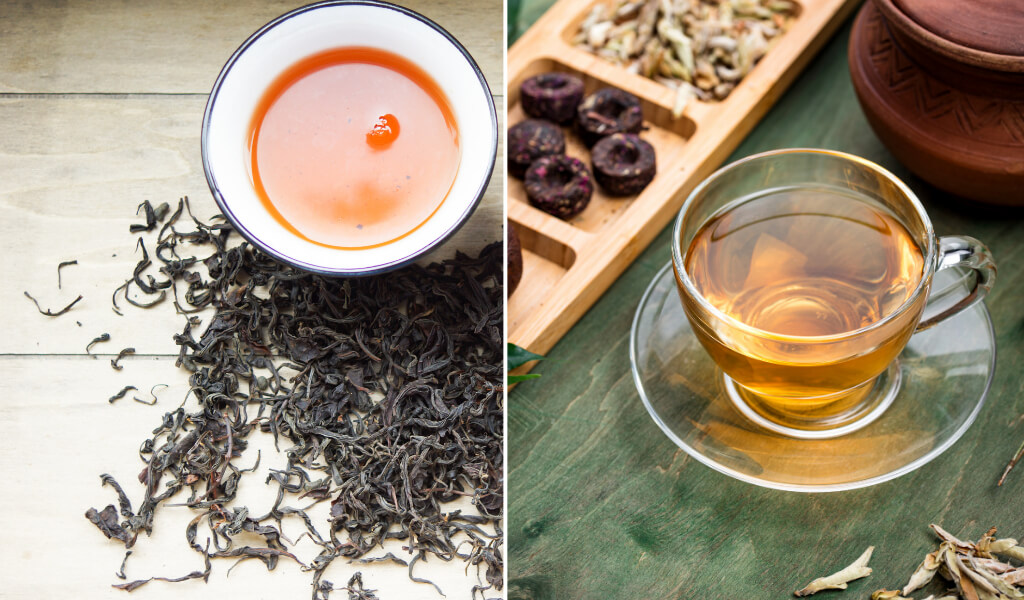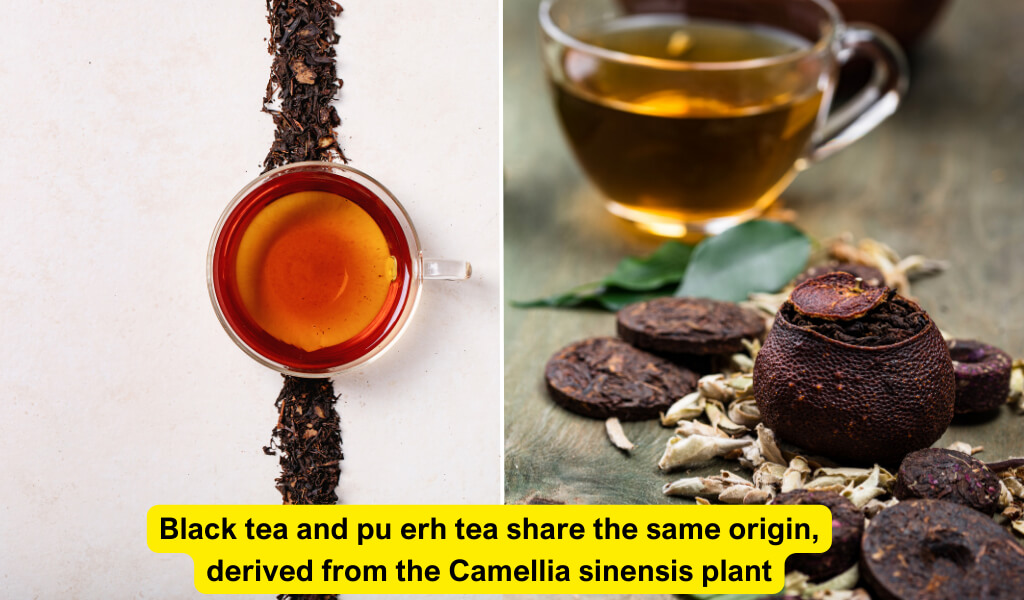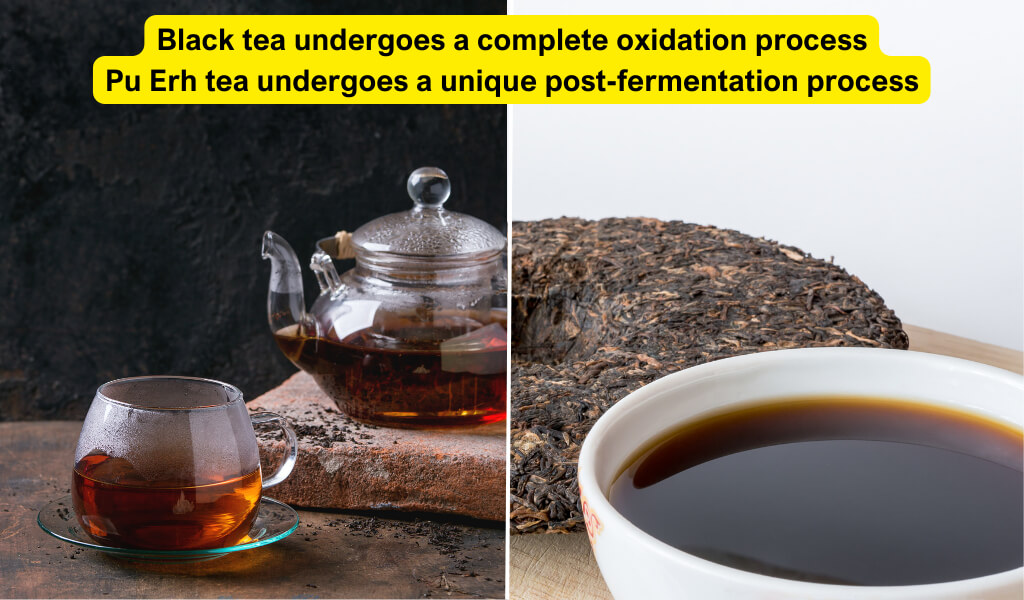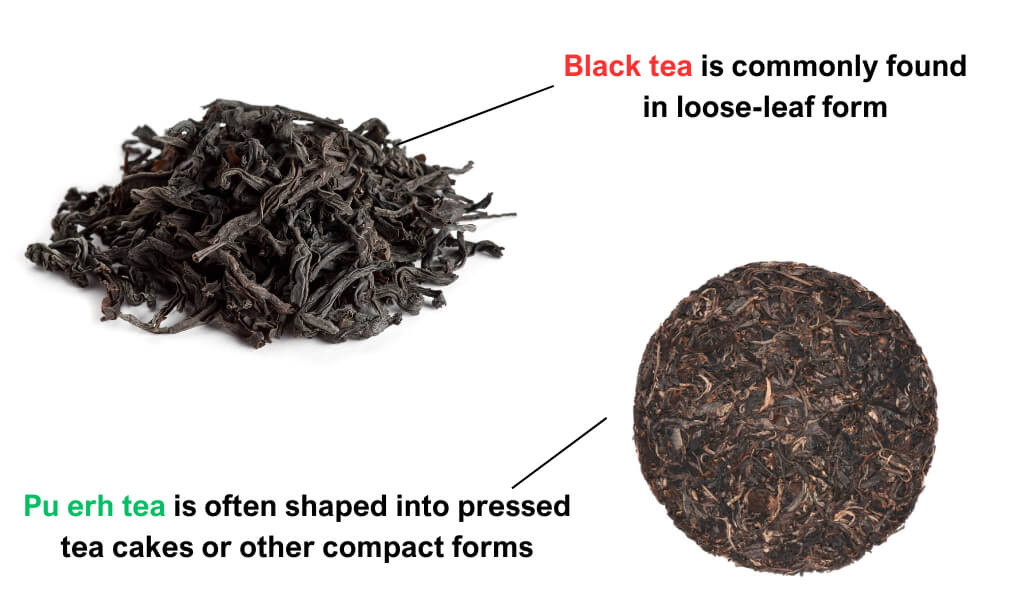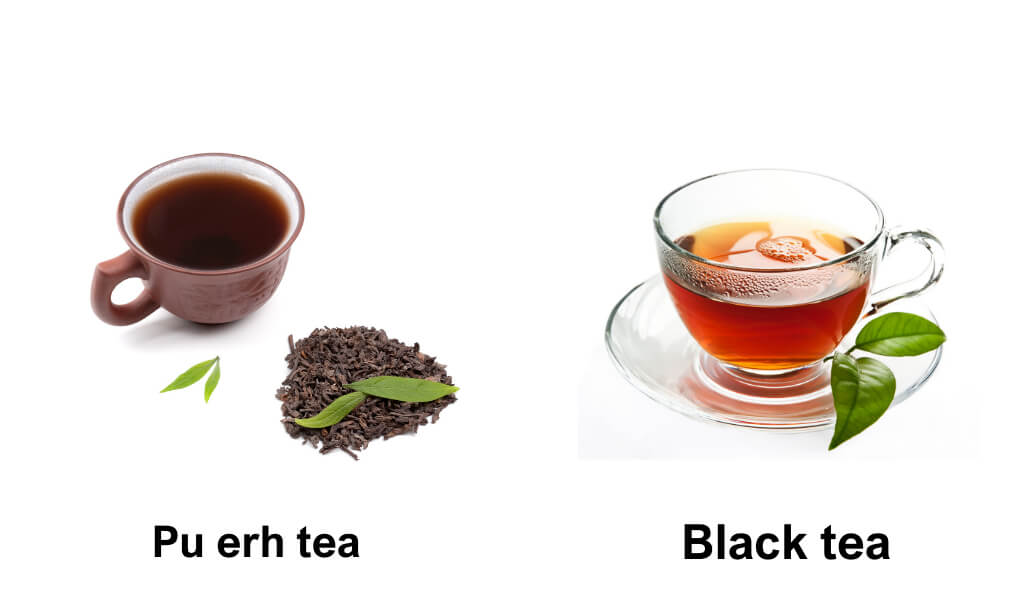As an avid tea lover, I’ve spent countless hours exploring the world of Black Tea vs Pu-erh Tea.
Each has its own appeal thanks to a long history and distinctive flavor profiles that set them apart in the broad tea world.
I can’t wait to take you on a tour of these two unique teas’ interesting environments.
Read More:
- Oolong vs Black Tea Comparison: Super interesting revelations
- Black Tea vs Green Tea: Some tips from tea Connoisseurs
- Black Tea vs White Tea comparison: Tastes, Nutrition and more
I’ll examine their history, production process, health advantages, and other factors before doing a thorough comparison that will allow you to recognize the minor differences and unique qualities of each.
Here’s a quick comparison chart between Black Tea vs Pu Erh Tea:
| Black Tea | Pu Erh Tea | |
| Common Origin | Derived from the Camellia sinensis plant | Derived from the Camellia sinensis plant |
| Oxidation and Fermentation | Highly oxidized, hearty flavor | Unique post-fermentation process, complex flavors |
| Cultural Importance | Cherished in global and local cultures | Cherished in global and local cultures |
| Production Process | Complete oxidation process | Unique post-fermentation process |
| Appearance | Loose leaf form | Pressed tea cakes or compact forms |
| Flavor | Robust, full-bodied taste | Earthy flavor with hints of mustiness |
| Color | Rich reddish-golden hue | Darker and deeper amber color |
| Cost | Generally more affordable | It can be more expensive due to rarity and aging processes |
| Health Benefits | Cardiovascular benefits, antioxidants | Digestion, weight management, cholesterol regulation |
| Caffeine | Higher caffeine content | Lower caffeine content |
| Nutrition | Rich in carotene, vitamin A, minerals, caffeine | Contains amino acids, alkaloids, polyphenols, caffeine |
Both black tea and Pu-erh tea have charming tales to tell, and I’m thrilled to take you further into their narratives, nuances, and comparisons in the coming sections.
Black tea vs pu erh tea: the basics
Let’s start with Black tea, one of the most renowned beverages globally. Originating from the Camellia sinensis plant in China, this tea has traversed centuries, finding its way into diverse cultures and traditions. I adore the special withering, rolling, oxidizing, and drying process that gives it its distinctive dark color and flavor. Black tea unquestionably makes an enduring statement in the tea market because to its rich history and distinctive flavor.
Black tea is not just a favorite in its birthplace, China, but also in many other parts of the world. For instance, the Assam and Darjeeling varieties are highly treasured in India. The same goes for the rich Ceylon variety from Sri Lanka. And who can forget the iconic English Breakfast and Earl Grey teas, staples in many households?
On to Pu-erh tea, a genuine jewel from China’s Yunnan province. With roots in the Tang Dynasty, this tea has a fascinating past. The distinctive post-fermentation procedure of Pu-erh is what distinguishes it and attracts me the most. It ages over time to acquire a depth of taste that is earthy, rich, and indisputably distinctive, much like a superb wine. Pu-erh is given a distinctive black colour by this fermentation, giving it a wonderful visual tea experience.
Similarities Between Pu Erh and Black Tea
Common Origin
Black tea and pu erh tea originate from the same plant, Camellia sinensis. These two teas are made mostly from this plant, commonly known as the tea plant, which is a native of East Asia. I find it amazing how one plant can provide such a wide range of flavors and qualities.
Oxidation and Fermentation
Both teas undergo a process that involves changes in color and flavor. Black tea is highly oxidized, which results in a dark reddish-gold color and a hearty, slightly bitter flavor. On the other hand, pu erh tea undergoes a unique post-fermentation process, which also causes the leaves to darken and the flavor to change. This similarity in their processing contributes to shared qualities in their final flavor profiles.
Cultural Importance
Both black tea and Pu-erh tea command a special place in the tapestry of global and local cultures. From the traditional Chinese tea ceremonies to the British afternoon tea, these beverages are not just about taste but also about the rich traditions and histories they represent. They have found their way into art, literature, and philosophy and are known for their potential health benefits.
Difference between pu erh and black tea
Now, let’s unravel the key differences separating pu erh tea from black tea.
Black tea vs pu erh tea nutrition And Production Process
When processing, black tea undergoes a complete oxidation process, which means the tea leaves are fully exposed to oxygen to achieve the desired flavor and color. In contrast, pu erh tea undergoes a unique post-fermentation process, allowing the tea leaves to age and develop complex flavors over time.
Pu’er tea production involves six steps: killing, kneading, sun-drying, stacking, sun-drying again, and sieving. Black tea production includes withering, rolling, fermenting, and drying, with Qihong requiring initial production and refining stages.
Appearance
Regarding appearance, black tea is commonly found in loose-leaf form, allowing the tea leaves to unfurl and release their flavors during brewing. On the other hand, Pu erh tea is often shaped into pressed tea cakes or other compact forms. This not only aids in preservation but also creates a visually appealing experience when preparing and serving the tea.
Black tea vs pu erh tea taste
Black tea has a powerful, full-bodied flavor that pleases the tongue. Depending on the type, it can have a variety of flavor characteristics, including malty, flowery, or fruity.
On the other hand, Pu erh tea has a unique, earthy flavor profile with a hint of mustiness every now and again. This exceptional flavor is derived from the post-fermentation process and the aging of the tea leaves, which over time generate rich and varied flavors.
Color
When brewed, black tea transforms into a rich reddish-golden hue, exuding warmth and inviting enjoyment. On the other hand, Pu erh tea yields a darker and deeper amber color, captivating the eye with its intensity. The beautiful colors of these teas add to the sensory experience of savoring a cup.
Cost
Generally, high-quality pu erh tea can be more expensive than black tea. Pu-erh tea’s value stems from rare ancient tea trees, intricate fermentation and aging, and high market demand.
Black tea vs pu erh tea health benefits
Both black tea and pu erh tea offer health benefits but have different focus areas. Black tea is often associated with its potential cardiovascular benefits and antioxidant properties.
On the other hand, pu erh tea is known for its potential benefits in digestion, weight management, and cholesterol regulation. Studies have shown that pu erh tea may have specific bioactive compounds contributing to these health effects, such as catechins and theaflavins in black tea and polyphenols in pu erh tea.
Caffeine
Black tea contains higher levels of caffeine compared to pu erh tea. However, it’s important to note that the exact caffeine content can depend on factors such as the brewing method, tea leaf quality, and steeping time. If you’re seeking a lower caffeine option, pu erh tea might suit you.
These differences in processing, flavor, color, cost, health benefits, and caffeine content contribute to the unique characteristics of black tea and pu erh tea. Exploring these distinctions allows us to appreciate the diversity that the world of tea has to offer.
Black tea vs pu erh tea nutrition
Black tea is rich in nutrients such as carotene, vitamin A, calcium, phosphorus, magnesium, potassium, caffeine, and amino acids.
Raw Pu’er tea has green, floral, and fruity aromas, while cooked Pu’er tea has honey, woody, and aged aromas. It contains amino acids, alkaloids, tea polyphenols, tannins, caffeine, pigments, monosaccharides, proteins, organic acids, lipids, and vitamins.
Choose black tea or pu erh tea?
Considering all this knowledge, it’s time to consider which tea, black or pu erh, is the perfect choice for you.
Black Tea: Choose black tea if you enjoy a robust flavor, potential cardiovascular benefits, and a higher caffeine content. It’s perfect for those who appreciate a strong taste and seek a stimulating boost.
Pu erh Tea: Opt for pu erh tea if you savor earthy and complex flavors, potential digestive benefits, and lower caffeine content. It’s ideal for those who prefer a unique taste experience and potential digestion and weight management support.
In conclusion
The comparison of black tea vs pu erh tea unveils the fascinating diversity within the world of tea. Both teas, originating from the Camellia sinensis plant, have unique production processes, flavors, colors, and cultural significance.
Black tea charms us with its robust taste and reddish-golden hue, while pu erh tea captivates us with its earthy and aged flavors.
Whether you prefer the rich complexities of black tea or the distinctive character of pu erh tea, both offer delightful experiences for tea enthusiasts. So, explore the nuances, savor each sip, and let the enchanting journey of tea continue.
See more articles here.
FAQs
Is pu erh black tea?
No, Pu-Erh tea is not the same as black tea. While both are made from the Camellia sinensis plant, they undergo different processing methods and have distinct flavor profiles and characteristics.
Which is better, Pu-Erh tea or black tea?
The choice between Pu-Erh tea and black tea depends on personal preference. Both teas offer unique flavors and potential health benefits. It ultimately comes down to individual taste and desired attributes, such as robustness (black tea) or earthiness (Pu-Erh tea).
Is Pu-Erh tea stronger than black tea?
Pu-Erh and black tea can vary in strength depending on the brewing method and tea leaf quality. Generally, black tea has a robust flavor, while Pu-Erh tea offers a unique and sometimes stronger earthy profile.
Does black tea or Pu-Erh tea help with weight loss?
Both black tea and Pu-Erh tea have been associated with potential benefits for weight management. Black tea may support weight loss by boosting metabolism, while Pu-Erh tea has been studied for its potential effects on fat metabolism and digestion.
Can I store black tea and Pu-Erh tea for a long time?
Both black tea and Pu-Erh tea can be stored for extended periods if stored properly. Black tea should be kept in an airtight container in a cool and dry place, while Pu-Erh tea can benefit from aging under suitable conditions. Proper storage ensures the preservation of flavor and quality over time.
Can I blend black tea and Pu-Erh tea?
You can blend black tea and Pu-Erh tea to create your unique tea blend. Experimenting with different ratios can result in a customized flavor profile that combines the robustness of black tea with the earthy notes of Pu-Erh tea. Feel free to explore and enjoy the art of tea blending!
I’m Shanna, creator of Spiritea Drinks. I’m all about teaching people to grow their own food, tea, cook what they harvest, and eat with the seasons.

